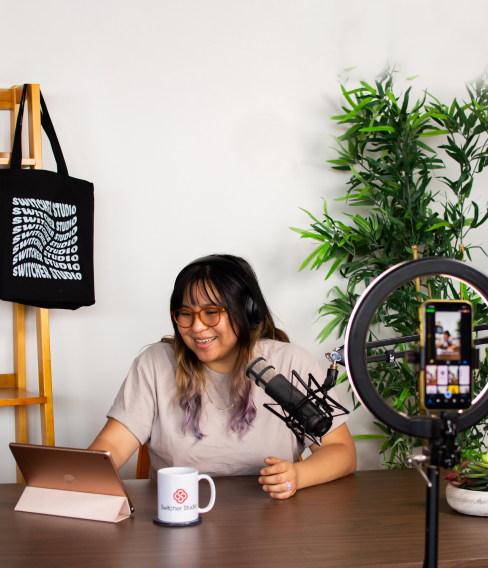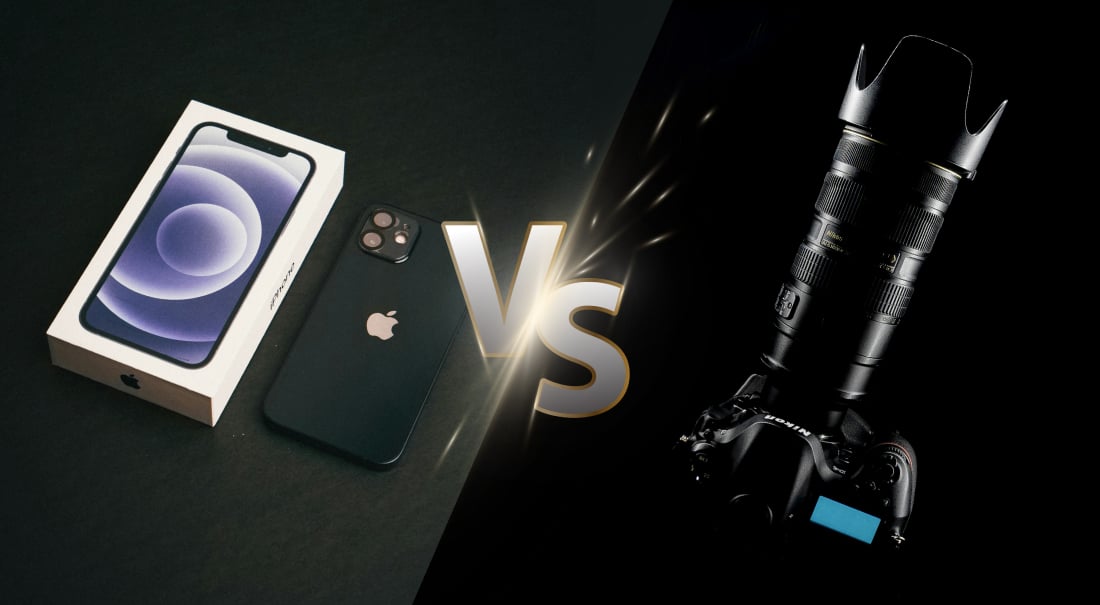Whether you’re setting up your first broadcast or upgrading your current rig, choosing what you’ll be streaming with is one of the first big decisions you’ll face. So … which should you pick?
DSLRs deliver cinematic quality. iPhones offer unmatched ease of use. And somewhere in between lies the setup that fits your workflow, your budget, and your real-world streaming needs. In this guide, we’re breaking down iPhone vs DSLR for live streaming — where each shines, what to consider, and how to make the best choice for your content.
iPhone vs DSLR — key differences

When it comes to live streaming, your camera isn't just a tool — it’s the foundation of your visual quality, workflow, and creative flexibility. iPhones and DSLRs each bring different strengths to the table, from convenience to control. Let’s go over the most important differences so you can decide which setup best fits your streaming style.
Video quality
Want crisp, cinematic video for your stream? DSLRs usually take the lead. They come equipped with larger image sensors, which allow them to capture more light and detail.
That means clearer video, smoother tones, and less grain — especially in indoor environments or evening events. They also produce that cinematic look that many creators aim for, with strong background separation and shallow depth of field.
Don’t get it twisted, though — iPhones have narrowed the gap significantly. The latest models can shoot in 4K, support HDR, and use computational photography features to enhance sharpness and exposure in real time. With good lighting and a stable setup, an iPhone camera can deliver impressive live streaming quality.
Still, there are limits. If consistency and technical quality are top priorities for your stream, a DSLR will give you more reliability.
Creative control
Creative control is where DSLRs really start to pull away from smartphones. With these cameras, you can manually adjust settings like shutter speed, ISO, aperture, and white balance — giving you full command over the look and feel of your stream.
Want a bright, airy feel? A moody, low-lit aesthetic? A blurred background to keep the focus on you? You can dial all of that in with precision. This kind of control also helps in tricky lighting environments or when your stream setup changes from one shoot to the next.

iPhones, on the other hand, are designed to make things easy. And they do that really well. They automatically adjust settings on the fly to keep your video balanced and usable, even as lighting conditions change.
This has pros and cons. The cons? iPhones try to auto-correct in real time, which means you could deal with sudden lighting shifts, focus jumps, and exposure swings mid-stream. You also can’t fine-tune your stream’s aesthetic to your liking like a DSLR can.
But the pros? DSLRs come with a learning curve, so they require patience and time to master. iPhones are pretty intuitive, which makes them perfect for beginners or creators who want to focus on content, not camera settings.
Flexibility and portability
When it comes to streaming on the move, iPhones are practically unbeatable. They’re lightweight, always on hand, and designed for mobile use — whether you're filming IRL content, quickly going live on Instagram, or capturing a behind-the-scenes moment at an event. With cellular data, built-in microphones, and streaming apps, your entire production studio can fit in your pocket.

DSLR cameras are far less nimble. They’re heavier, bulkier, and usually require additional streaming hardware. That makes them more ideal for controlled environments like podcast studios or control rooms, but less practical for on-the-fly content.
There’s also less flexibility with framing and repositioning once your DSLR is locked into place. Meanwhile, iPhones make it easy to switch angles, go handheld, or reposition in seconds, an advantage for solo streamers or anyone trying to capture dynamic footage in real time.
Cost and accessibility
If you already own a relatively new iPhone, you may not need to spend anything to get started.
You can go live, add graphics, and monitor your stream — all from a single device. If you’re starting from scratch, the cost of an iPhone can still be significant, but you're also getting a versatile everyday device that serves more than one purpose.
DSLRs, on the other hand, require a larger upfront investment. Beyond the camera body, you'll need to factor in lenses, a capture card, a computer for streaming software, and audio equipment. The result can be stunning, but it comes at a price — often totaling several hundred to a few thousand dollars, depending on how advanced your setup is.
What about mirrorless cameras?
Mirrorless cameras are often mentioned in the same breath as DSLRs, and while they share some strengths — like interchangeable lenses and large sensors — they’re not identical.

The biggest difference? No internal mirror means mirrorless cameras are typically lighter, quieter, and more compact than their DSLR counterparts. For live streamers, that makes them a bit more appealing if you're looking for high image quality without the full bulk of a DSLR.
That said, mirrorless cameras still come with many of the same tradeoffs. They often require external gear to be stream-ready (like capture cards, mics, and mounts), and there’s still a learning curve when it comes to navigating settings and getting the most out of the hardware.
So if you're looking to level up from a phone and want to experiment with more creative control, a mirrorless camera might be worth the investment. But for fast-paced, on-the-go streaming, a smartphone still wins for simplicity and speed.
Best camera for your streaming goals
Still not sure if an iPhone or DSLR is the right fit for you? Let’s go over a few common live streaming scenarios and which might serve you best.
-
Sports streaming (sidelines, courtside, on the go): iPhones offer fast setup, mobility, and multi-cam capabilities (when paired with an app like Switcher) — all without the need for extra gear.
-
Worship services (weekly sermons, events, worship music): For smaller or mobile churches, iPhones offer a reliable, low-lift way to stream weekly services. But if you’re a larger church with a dedicated media team, you might want to choose DSLR for more cinematic visuals.
-
Studio productions (interviews, podcasts): DSLR or mirrorless cameras give you more control over depth of field and lens selection, ideal when you have the time and space to set up.
-
Ticketed events (concerts, conferences): If you're streaming a paid event where a polished, professional look adds value to the experience, a DSLR or mirrorless camera can help you justify the price tag with crisp video quality.
-
IRL content creation (behind-the-scenes, vlogs): iPhones are lighter, more discreet, and perfectly suited for spontaneous or mobile content.
Bridge the gap between phone and pro gear
You can choose iPhones or DSLRs to stream … or you could cheat a little and choose a secret third option! Slightly kidding — but if you’re looking for a middle ground between pro-level cameras and the simplicity of your phone, the Accsoon SeeMo might be your answer.
This compact HDMI adapter directly connects any camera or device with an HDMI output to your iPhone or iPad, turning your iOS device into a full-fledged production monitor and a streaming encoder. You can keep your mobile, app-based workflow while tapping into the image quality of a DSLR or mirrorless camera.
This is an option for creators who want to elevate their stream’s visual quality without building an entire desktop setup. AKA the hybrid setup that gives you the best of both worlds.
Build the setup that works for you
Framing your decision as iPhone vs DSLR for live streaming is a great place to start — but it’s not where it ends. Whether you choose to stream with an iPhone, a DSLR, or a hybrid of both, the biggest impact comes from a setup that fits you. With the right tools, high-quality, professional streaming isn’t just possible — it’s easy.
And if the right tool is using your iPhone for streaming, we know a guy who can help make that incredibly simple. It’s us. We’re the guy. Sign up for a free trial of Switcher and see how simple and powerful iPhone live streaming can be!
Subscribe to the blog
Sign up to receive notifications whenever a new blog post is published. You may unsubscribe at any time.

Share
About the Author

Carly is a content specialist at Switcher and is passionate about creating informative and engaging blog and social media material. With her background in digital marketing and degree in writing, she’s here to help others learn about our features and all things video content.
All posts by Carly Cowie

